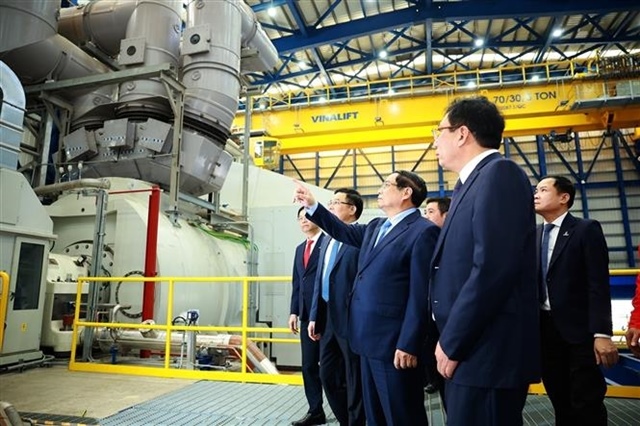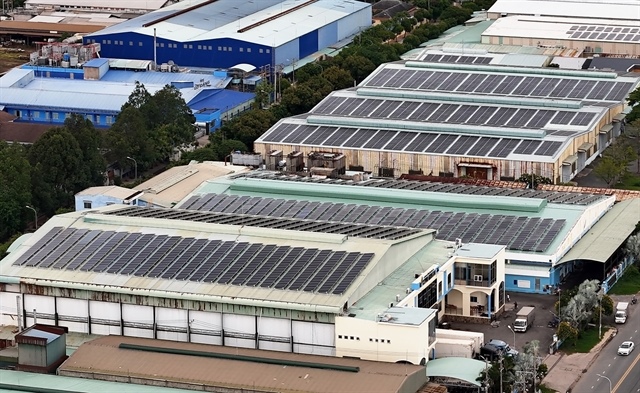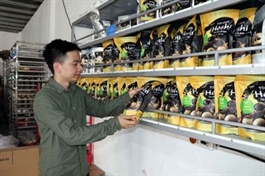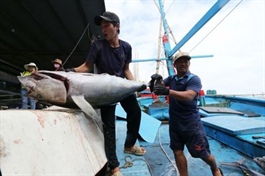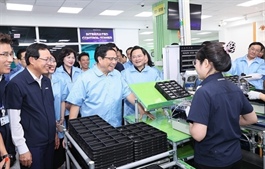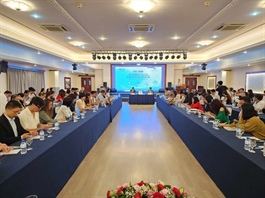Large-scale, hi-tech pig farming is evitable for development: MARD
Large-scale, hi-tech pig farming is evitable for development: MARD
The pig-raising industry needs a long-term development strategy seeing as the price of animal feed is nearly 70 per cent of total costs, said deputy minister of Agriculture and Rural Development Phùng Đức Tiến.
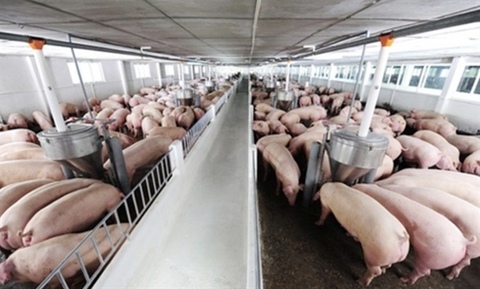
A hi-tech pig farm in Quảng Trị Province. — Photo baodautu.vn |
Besides, the industry must focus on processing and high-tech animal husbandry, Tiến said in the meeting on implementing solutions to promote the pig-raising industry organised by the Ministry of Agriculture and Rural Development (MARD) in Hà Nội late last week.
In the first half of this year, pork production reached 2.32 million tonnes, up 5.4 per cent and the total number of pigs is estimated to have increased by 2.5 per cent over the same period last year.
Pork prices increased since June, with prices ranging from VNĐ60,000 to 67,000 (US$2.5-2.8) per kilo.
The increase in pork prices was a good sign for farmers and the agricultural industry, said the deputy minister.
“There are risks of epidemic outbreaks with many strains of influenza viruses and other diseases imported from abroad,” said Tiến.
“The price of animal feed is still high and the illegal import of livestock products is still uncontrolled,” he said.
“For months, the ministry, farmers and the relevant agencies had found solutions to handle the situation. The efforts have paid off as prices of livestock products, especially pork, have increased again,” he added.
He asked the livestock industry to be proactive in dealing with difficulties in the face of disease developments and the increase of raw material and food prices in the second half of this year.
The industry would need to be well prepared with food sources from now until the Tết (Lunar New Year), with demand increasing by 15-20 per cent.
The pig industry would need to increase exports as the potential advantages here are large.
Building an autonomous livestock industry was necessary to solve the problem of animal feed.
"The country's corn yield is about 4 million tonnes. It's impossible to import corn and soybeans forever. We must have a solution," Tiến told the meeting.
Phạm Kim Đăng, deputy director of the ministry’s Livestock Production Department, said pig production had shifted from small-scale household farming to large-scale farms.
In the past five years, the rate of household husbandry had decreased by 5-7 per cent per year, especially in 2019 and 2022 alone by 15-20 per cent, Đăng told the meeting.
Currently, pork production in smallholder farmers had been reduced to 35-40 per cent of the total.
The structure of the pork supply in 2022 showed that household enterprises accounted for only 19 per cent, livestock households accounted for 38 per cent, and FDI enterprises made up 43 per cent.
Large-scale domestic livestock enterprises such as Dabaco, Masan, Tân Long, Thiên Thuận Trường, Mavin, Greenfeed, Trường Hải and Hoà Phát and foreign-invested companies such as CP, Japfa Comfeed, New Hope, CJ, Emivest and Cargill were building and gradually forming a chain-link farm system.
This was one step in restructuring livestock production to gradually modernise the livestock industry.
Pork is one of the main foods used daily by Vietnamese people.
At present, in the structure of meat consumption of Vietnamese people, pork accounts for 73.3 per cent, poultry meat is 17.5 per cent and only the remaining 9.2 per cent is red meat including beef, buffalo, goat and lamb.
Việt Nam’s pig industry has a large domestic market of nearly 100 million people, let alone the number of international tourists increasing year by year. These are advantages for the development of the pig industry in the coming time, according to Đăng.
The Strategy on Livestock Development to 2030 sets a goal of 30 million pig heads every year, of which the sow herd is about 2.5 million heads, carcass meat about six million tonnes and export is 15-20 per cent of pork production.
Đăng said the industry would focus on enhancing bio-safety pig production, controlling epidemics, building links, effectively managing pig breeds, developing indigenous and endemic breeds, protecting the environment, and applying high technologies.
Disease control
According to deputy director of the Department of Animal Health Phan Quang Minh, to develop pig farming in a sustainable way, the industry must carry out three main veterinary tasks of disease prevention, slaughter control and animal quarantine.
The biggest threat today is still African swine fever which first occurred in Việt Nam in 2019 and caused losses of VNĐ13.2 trillion ($556 million).
Up to now, the disease still makes it difficult for many farmers to restore the production.
However, in June last year, Việt Nam successfully produced a vaccine against African Swine Fever. This is considered a “steel shield” to prevent the disease that caused the country to kill more than 6 million pigs.
A number of other common diseases in pigs such as foot-and-mouth disease and blue ear are currently being vaccinated against.
In order to effectively prevent epidemics, it is necessary to build disease-free areas.
The Department of Animal Health held four related conferences and set up many inspection teams to localities to guide, supervise and strengthen disease prevention and control.
In the first six months of this year, 130 disease-free facilities for pigs were built. And the department advised the ministry to develop safe areas of free foot-and-mouth disease to export pork to China.





